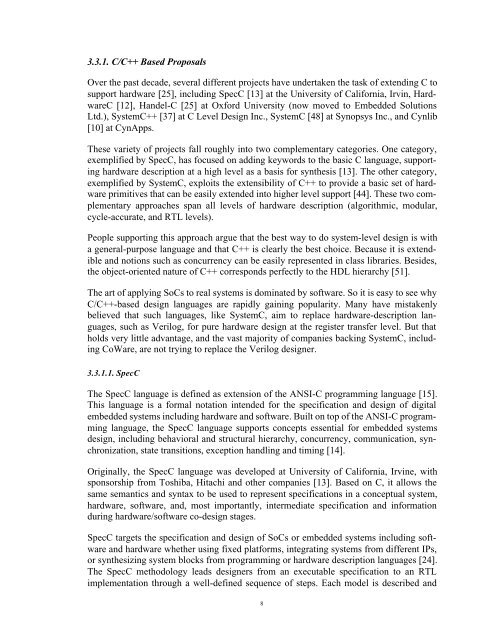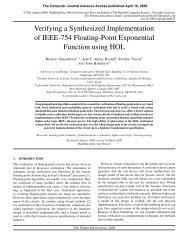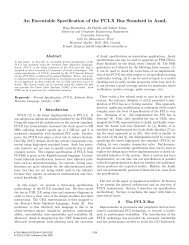PDF File - Hardware Verification Group - Concordia University
PDF File - Hardware Verification Group - Concordia University
PDF File - Hardware Verification Group - Concordia University
You also want an ePaper? Increase the reach of your titles
YUMPU automatically turns print PDFs into web optimized ePapers that Google loves.
3.3.1. C/C++ Based Proposals<br />
Over the past decade, several different projects have undertaken the task of extending C to<br />
support hardware [25], including SpecC [13] at the <strong>University</strong> of California, Irvin, <strong>Hardware</strong>C<br />
[12], Handel-C [25] at Oxford <strong>University</strong> (now moved to Embedded Solutions<br />
Ltd.), SystemC++ [37] at C Level Design Inc., SystemC [48] at Synopsys Inc., and Cynlib<br />
[10] at CynApps.<br />
These variety of projects fall roughly into two complementary categories. One category,<br />
exemplified by SpecC, has focused on adding keywords to the basic C language, supporting<br />
hardware description at a high level as a basis for synthesis [13]. The other category,<br />
exemplified by SystemC, exploits the extensibility of C++ to provide a basic set of hardware<br />
primitives that can be easily extended into higher level support [44]. These two complementary<br />
approaches span all levels of hardware description (algorithmic, modular,<br />
cycle-accurate, and RTL levels).<br />
People supporting this approach argue that the best way to do system-level design is with<br />
a general-purpose language and that C++ is clearly the best choice. Because it is extendible<br />
and notions such as concurrency can be easily represented in class libraries. Besides,<br />
the object-oriented nature of C++ corresponds perfectly to the HDL hierarchy [51].<br />
The art of applying SoCs to real systems is dominated by software. So it is easy to see why<br />
C/C++-based design languages are rapidly gaining popularity. Many have mistakenly<br />
believed that such languages, like SystemC, aim to replace hardware-description languages,<br />
such as Verilog, for pure hardware design at the register transfer level. But that<br />
holds very little advantage, and the vast majority of companies backing SystemC, including<br />
CoWare, are not trying to replace the Verilog designer.<br />
3.3.1.1. SpecC<br />
The SpecC language is defined as extension of the ANSI-C programming language [15].<br />
This language is a formal notation intended for the specification and design of digital<br />
embedded systems including hardware and software. Built on top of the ANSI-C programming<br />
language, the SpecC language supports concepts essential for embedded systems<br />
design, including behavioral and structural hierarchy, concurrency, communication, synchronization,<br />
state transitions, exception handling and timing [14].<br />
Originally, the SpecC language was developed at <strong>University</strong> of California, Irvine, with<br />
sponsorship from Toshiba, Hitachi and other companies [13]. Based on C, it allows the<br />
same semantics and syntax to be used to represent specifications in a conceptual system,<br />
hardware, software, and, most importantly, intermediate specification and information<br />
during hardware/software co-design stages.<br />
SpecC targets the specification and design of SoCs or embedded systems including software<br />
and hardware whether using fixed platforms, integrating systems from different IPs,<br />
or synthesizing system blocks from programming or hardware description languages [24].<br />
The SpecC methodology leads designers from an executable specification to an RTL<br />
implementation through a well-defined sequence of steps. Each model is described and<br />
8





